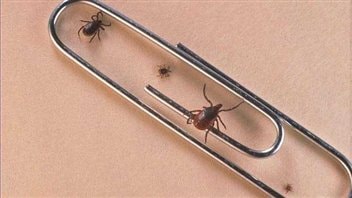Bugs are common in the summer in Canada, Pesky biting bugs, like black flies and mosquitoes, and in recent years with some of those bites comes concerns over disease, such as West Nile.
This year however worries of mosquitoes carrying the West Nile Virus is low, according to entomologist Ken Deacon. Because of that the Thunder Bay District Health Unit is reducing their fight against the flying pests to concentrate on a new problem. The increase in ticks carrying Lyme disease.

blacklegged ticks. (Getty Images) © Getty Images
Lyme disease is named after the town where it was first identified in the 1970’s, Lyme, Connecticut, in the USA.
It was unknown in Canada up until the 1980s. Initially, it was identified only at Long Point and Point Pelee, Ont. — which is the farthest south you can get in Canada. Since then, Lyme disease has become established from Nova Scotia to B.C., except for Alberta and Saskatchewan.
Mr Deacon said, last year the Thunder Bay Health unit collected almost no deer ticks, also known as black-legged ticks. But he says, they’ve gone from almost no ticks in 2005 to over a thousand last year, and have collected 500 so far this year.
How do ticks pass on the disease?
Ticks go through three feeding stages: larvae, nymph and adult. When a young tick feeds on an infected animal, it picks up a bacterium called Borrelia burgdorferi. It’s normally carried by mice, squirrels, birds and other small animals.
The bacterium then lives in the gut of the tick. If you are the tick’s next meal after it’s ingested infected blood, you could show symptoms in three to 30 days.
Most cases are reported in late spring and summer, when the young ticks are most active and people are outdoors more often. The deer tick gets its name from feeding often on deer, which they don’t often infect. The deer not only provide a food source but help spread the ticks.
Health Canada estimates that about 10 per cent of blacklegged ticks in any infected area carry the bacterium that causes Lyme disease.
The first sign that you may be infected is a circular rash surrounding the spot where the tick bit you. It’ll show up between three and 30 days after the tick bite. The rash may be followed by symptoms like fatigue, chills, fever, headache, muscle and joint pain and swollen lymph nodes.
If left untreated, the disease can progress to a second phase, which can last several months. Symptoms in the second phase include migraines, weakness, multiple skin rashes, painful or stiff joints, abnormal heartbeat and extreme fatigue.
Without treatment, it’s highly unlikely that you will die, but you may suffer symptoms such as chronic arthritis and neurological symptoms, including headaches, dizziness, numbness and paralysis.
Lyme disease is generally easy to treat with antibiotics in its early stages. But if left too long, treatment may involve several rounds of antibiotics.
Nova Scotia zoologist Andrew Hebda notes that ticks aren’t very active. They can’t leap at you as you walk by. But if you brush up against them as they wait on tall grasses or other plants, they can latch on to you, or your pet. Dogs often are targets and ticks might be found on the head and neck of your pet.
If you find a tick embedded in your skin or that of your pet, Hebda say to, use tweezers to carefully remove it without detaching its tiny mouth. It’s virtually impossible to identify species of ticks without the mouth part. Health Canada labs will not analyze ticks if they are missing the mouth.
“If you can’t remove it,” Hebda says, “see your family physician.”
Ticks can pass on more than just Lyme disease. These include:
Human granulocytic anaplasmosis — a disease that is often difficult to diagnose because symptoms can be non-specific. Most people experience headaches, fever, chills, myalgia and an overall sensation of not feeling well.
Human babesiosis — a malaria-like infection first identified in the U.S. on Nantucket Island in Massachusettes.
Powassan encephalitis virus — a potentially deadly disease named for the Ontario town where it was first diagnosed. There have been as many as 27 cases across North America since 1958.
Tick-borne illnesses normally present themselves between June and September.
With files from CBC







For reasons beyond our control, and for an undetermined period of time, our comment section is now closed. However, our social networks remain open to your contributions.